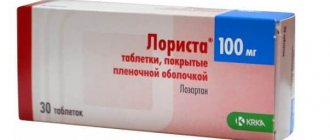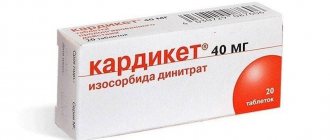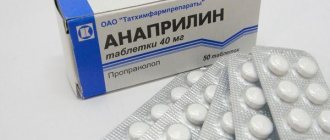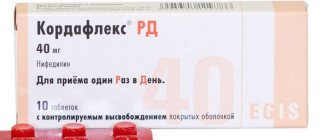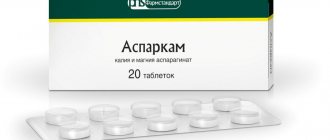Hypertension is a fairly common disease that affects not only people of retirement age, but also the younger generation. In the absence of therapeutic effects, the disease is complicated by the occurrence of ischemic myocardial disease, stroke, and other types of problems of the cardiovascular system. To prevent the serious consequences of high blood pressure and improve the patient’s well-being, Prestarium is prescribed, instructions for use are given below. Before starting to use the drug, it is recommended to familiarize yourself with the indications for use and identify any contraindications Prestarium may have.
Composition, release forms, varieties and names
The drug Prestarium is a medicinal product produced on the Russian market. The production of the drug takes place in France.
Sales are carried out in several forms of release:
- 2, 4 and 8 mg;
- Prestarium A 5 mg, 2.5, and there is also a norm of 10 mg;
- Bi-Prestarium 5+5, 10+10 and Bi-Prestarium 10+5 milligrams, which include Amlodipine.
According to the instructions, Prestarium A contains in its list of important ingredients the active substance - perindopril (according to the INN). Prestarium combi contains indapamide.
Prestarium tablets in a dosage of 2.8 mg are round, convex. A dose of 2.2.5 mg is represented by a whitish tint, pellets of 8.10 mg are represented by a greenish color.
Tablets 4.5 mg – capsules, elongated. The shade of the dragee is soft green. The tablet is heterogeneous, with minor inclusions.
International nonproprietary name – Perindopril.
Prestarium: features of the drug
The drug is known under the trade name “Prestarium® A” (Prestarium A). Its international nonproprietary name is perindopril arginine. The drug in question, according to the classification, belongs to the group of ACE inhibitors. Doctors consider the original drug to be the most studied medicine used in the treatment of hypertension. Large international studies were conducted in the 1990s and early 2000s. About 50 thousand patients took part in the experiment.
According to the results of the study, experts noticed that the medicine significantly improves the prognosis for arterial hypertension, chronic heart failure, and coronary heart disease. Doctors successfully use the drug to treat patients with diabetes mellitus, metabolic syndrome, and after a stroke or heart attack.
During the experiment, each participant in the program took the original drug. Experts have recorded the following effects of the drug:
- reducing the risk of first, recurrent stroke, heart attack;
- reduction in overall and cardiovascular mortality;
- lowering blood pressure;
- inhibition of the development of atherosclerosis;
- beneficial effect on blood vessels.
Therapeutic effect of Prestarium
The active component of the medication blocks the formation of an enzyme, which, when increasing, stimulates the formation of spasms in the blood arteries. There is a decrease in blood pressure in patients with hypertension. Therefore, many people know Prestarium as blood pressure pills.
As the active substance acts, it affects aldosterone: its production decreases. When using the drug, increased renin activity is observed, and the breakdown of bradykinin into small particles increases.
According to the instructions for use, Prestarium does not affect myocardial contractions. But the effect of the active substance increases blood supply to the kidneys. The walls of blood vessels become elastic. This process is especially observed with large capillaries that directly follow the heart muscle. This stimulates a reduction in the size of the left ventricular myocardium.
If Bi-Prestarium is prescribed, the medicine is aimed at blocking calcium channels and expanding the lumen of blood capillaries. Amlodipine, which is included in the composition, does not have a negative effect on metabolism in the body.
After taking Prestarium A, the active substance is maximally concentrated in the systemic circulation within 1 hour. The substance is excreted primarily through the kidneys, in the form of urine.
According to the annotation, the onset of the expected effect is detected only on the 4th day after daily use.
How to help with blood pressure
As a result of inhibition of angiotensin activity, Prestarium relieves arterial spasm, facilitating peripheral circulation. The important thing is that this happens without changes in heart rate and strength. When using the drug, the distensibility of the walls of large vessels and the patency of arteries of smaller diameter increases.
The drug can be used for all forms of arterial hypertension - from mild to severe, it affects systolic and diastolic parameters equally, and lowers blood pressure quickly and sustainably.
The onset of the hypotensive effect is observed an hour after administration, reaches a peak in the fifth hour, and lasts for at least a day. Prestarium manages to normalize the condition of patients with hypertension in the first month of treatment; during a course of treatment there is no addictive effect or worsening of the condition upon withdrawal.
The drug activates renal hemodynamics without impairing filtration ability. One of the advantages is the ability to reduce the degree of hypertrophy of left ventricular muscle fibers.
Indications for use
Prestarium helps against high blood pressure and in certain situations:
- Hypertension.
- Heart failure that occurs over a long period of time and is recorded as chronic.
- Ischemic myocardial disease.
- For circulatory disorders in the brain.
Prestarium is prescribed for blood pressure and for preventive purposes to prevent the development of cardiac pathologies. Prestarium A tablets can be used for a long time - the drug does not cause addiction or side effects after withdrawal.
Reviews
Literally since the beginning of the 2000s, the drug in question has been used in the complex therapy of hypertension, coronary heart disease, and heart failure. The tablets have become very popular among both patients and doctors.
Patients leave many positive reviews about the drug Prestarium. Among the advantages they note:
- Smooth action.
- Rare side effects.
- Favorable effect on blood vessels.
- Well tolerated by elderly patients.
Cardiologists call the following advantages of the drug:
- The ability to combine with other medications (aspirin, statins, Magi-B6, beta blockers, diuretics).
- Ease of use. You need to take one tablet per day.
- Absence of complaints from most patients about side effects.
- Maintains therapeutic effect for 24 hours.
Among the minuses, patients point to the weak effect of Prestarium A. Indeed, the medicine may not lower blood pressure enough. It is more effective in combination therapy with other drugs for arterial hypertension.
Prestarium instructions for use
Prestarium is recommended to be taken in the morning or evening. It is advisable to administer the tablets before eating, immediately after waking up.
The medicine is used in the minimum dose - Prestarium 5 mg. If effectiveness does not appear within 28 days, then the dosage should be doubled.
Analogues of the drug
In some cases, the drug can be replaced with synonymous drugs. Such analogues of Prestarium A are based on perindopril and have an identical effect. Among them:
- Perineva. The drug, produced in Russia under the control of a European brand, is quite often prescribed as an alternative. However, the dosages of the products differ. Perineva 4 mg is an analogue of Prestarium 5 mg, and Perineva 8 mg replaces the 10 mg synonym.
- Arentopres. The manufacturer is India. The price is quite high; sometimes the drug cannot be found in the nearest pharmacy.
- Perindopril-Richter. A high-quality Hungarian remedy that helps quickly lower blood pressure.
There are other analogues of the drug. You should consult your doctor about the possibility of replacing the product.
Scheme and dosage of treatment with Prestarium
Prestarium 5 or 10 mg is taken once a day. You need to take the medicine on an empty stomach. The dosage of Prestarium depends on the disease identified during an appointment with a cardiologist:
- Arterial hypertension - 4 mg is prescribed.
- Heart failure – 2 mg per day.
- For preventive purposes, it is taken in a minimal dose.
- Coronary heart disease - take 5 mg for 14 days.
If the results are positive, the norm does not increase. In the absence of the expected result, the norm is doubled. The dosage for elderly patients is subject to adjustment.
Prestarium: brief description
The drug belongs to the class of ACE inhibitors, the main active ingredient is perindopril arginine. Indications for use of Prestarium include arterial hypertension, cardiovascular failure and other conditions accompanied by chest pain, increased blood pressure and other symptoms. The active substance normalizes the functioning of the heart and blood vessels, increases exercise tolerance and reduces left ventricular hypertrophy.
Prestarium is usually taken in combination with other medications, most often with potassium-sparing diuretics.
Prestarium is available in tablets, which are taken daily in the morning on an empty stomach. The starting dose is 2 mg, after which it is increased to 4-8 mg.
Side effects include gastrointestinal disorders, headaches and changes in clinical blood test values, contraindications - pregnancy, lactation, individual intolerance.
Dosage regimen for treatment with Prestarium A
It is difficult to determine exactly what is better: Prestarium or Prestarium A. Therefore, doctors initially recommend using one drug if its actions are not sufficiently replaced.
The dosage and regimen for the drug is recommended individually for each patient.
The following treatment regimen is distinguished:
- Hypertension - 5 mg is administered before meals. If necessary, the norm increases, you can take Prestarium A 10 mg. In some situations, on the contrary, it is reduced to 2.5 mg.
- Heart failure - under constant medical supervision 2.5 mg. Can be adjusted up to 5 mg.
- As a prevention of stroke - 2.5 mg for 14 days, then the dosage is increased to 5 mg.
The duration and frequency of treatment is determined by the attending physician based on the identified disease and the severity of its course.
Prestarium drug overdose, symptoms and treatment
Symptoms of an overdose of any ACE inhibitors are severe hypotension, circulatory shock, tachycardia, bradycardia, electrolyte imbalance, renal failure, hyperventilation, dizziness, anxiety. In case of overdose, the patient should be hospitalized and under the supervision of a physician. The level of electrolytes and creatinine in the blood plasma should be monitored. Treatment depends on the nature and severity of symptoms. It is necessary to reduce the absorption of the ACE inhibitor by gastric lavage and the administration of enterosorbents. In case of severe arterial hypotension, the patient must be placed in a horizontal position with the head down and the blood volume must be restored by infusion of isotonic sodium chloride solution. If necessary, angiotensin II and/or catecholamines are administered intravenously. In severe cases, temporary implantation of a cardiac pacemaker is indicated. It is necessary to monitor and correct the vital functions of the body. Perindopril can be removed from the body using hemodialysis. The use of high-flow membranes is not recommended.
Use during pregnancy and breastfeeding
The use of the medication is prohibited throughout pregnancy, and not just after conception. In this case, the drug can be replaced. This is due to the fact that the active substance has the ability to penetrate the placental barrier and affect the fetus.
In the second half of gestation, drug treatment is unacceptable due to decreased kidney function. In some situations, a decrease in amniotic fluid is detected. At the same time, the active substance negatively affects the fetus, stimulating pathological processes and developmental defects.
It was not possible to accurately determine through clinical studies whether the active substance is secreted into breast milk. Therefore, the use of the medicine is not recommended during breastfeeding.
Pharmacological action, pharmacodynamics
Perindopril is classified as an ACE inhibitor. Angiotensin-converting enzyme (kininase II) is an exopeptidase capable of converting angiotensin I into a vasoconstrictor substance (angiotensin II), destroying bradykinin (a substance that has a vasodilator effect) to an inactive heptapeptide.
When ACE inhibition is observed, there is a decrease in the concentration of angiotensin II in the blood plasma. At the same time, the activity of plasma renin increases and the secretion of aldosterone decreases. Given the fact that ACE inactivates bradykinin, an increase in the activity of the circulating tissue kallikrein-kinin system is observed when ACE is suppressed. Activation of the prostaglandin system is also noted. Experts believe that this effect is part of the mechanism of the antihypertensive effect of ACE inhibitors.
The therapeutic effect of the drug is possible thanks to the active metabolite, perindoprilat. The remaining metabolites of the drug are unable to have an inhibitory effect on ACE. The drug lowers blood pressure (systolic, diastolic). There is an acceleration of peripheral blood flow, the pulse rate remains normal (the indicator does not increase).
The medication helps restore the elasticity of large and small arteries and dilate blood vessels. Under the influence of perindopril, there is a normalization of heart function, a decrease in pre- and afterload, and a decrease in left ventricular hypertrophy. Stopping taking the pills does not cause withdrawal symptoms.
special instructions
When prescribing the medicine to patients suffering from hypertension, who follow a specific diet, and also take diuretics, it is necessary to warn the cardiologist about this. If a dry cough or allergic rash occurs while taking the medicine, you should also consult your doctor. Perhaps the drug is not suitable and you will have to look for analogues.
In some situations, during treatment there is a possibility of swelling of the lower extremities.
The duration of treatment for heart disease is regulated by a doctor. Usually the course of therapy is long, you have to take the medicine for a long time. Therefore, many are interested in the compatibility of Prestarium and alcohol.
It is highly not recommended to combine Prestarium and alcohol. The consequences of use are severe headaches, a sharp decrease in blood pressure, identification of signs of intoxication, and the likelihood of developing a stroke. Therefore, during treatment you should not abuse alcohol.
Useful video
How to take Prestarium for high blood pressure? Instructions in the video:
Prestarium is an effective modern remedy against hypertension from the middle price segment. Can be combined with other antihypertensive drugs.
The information on the MyMedNews.ru website is for reference and general information, collected from publicly available sources and cannot serve as a basis for making a decision on the use of medications in the course of treatment.
MyMedNews.ru
And we also have
Is it possible to do without antihypertensive pills if you have problems with blood pressure?
Overdose
When the dosage is increased or the medication is taken incorrectly, symptoms of overdose appear. The following diseases or situations are formed:
- Shock.
- A sharp decrease in blood pressure.
- Change in electrolyte balance.
- Bradycardia.
- Detection of dizziness.
When such phenomena are detected, it is necessary to place the person in a horizontal position. Catecholamines and Angiotensin are supplied intravenously to the body.
How do dispersible tablets differ from regular tablets?
The release form of a dispersible tablet ensures that when it enters the oral cavity, it disintegrates into pieces on its own and does not require effort when swallowing or mandatory washing down with water . They can be used for patients who cannot swallow a regular tablet due to neurological disorders (after a stroke), the need to remain in a horizontal position (bedridden patients, during the dialysis procedure).
Such situations can also arise if there is a refusal of treatment - mental disorders, dementia.
In addition, solubility in the mouth ensures accelerated and complete absorption and rapid penetration into the blood.
Dispersible tablets are convenient for working and actively traveling people, since they do not need to carry water with them to take the medicine.
Side effects
If the dosage is incorrect, side effects occur. They are manifested by the following symptoms:
- Sleep problems.
- Intense pain in the head.
- Depression.
- Nausea and severe vomiting.
- Changes in the perception of taste by receptors in the mouth.
- Dry mouth.
- Decreased hemoglobin levels and the level of red blood cells in the lymph.
When treated with Prestarium, side effects can also include cough, allergies, decreased potency in men, Quincke's edema or redness of the skin.
If the doctor has established a normal dosage, but side effects are detected, then it is necessary to select a substitute for Prestarium.
Possible side effects
Prestarium is well tolerated in most cases, but there is a possibility that taking it will cause side effects. Thus, the medicine should be discontinued if the patient begins to develop a dry cough.
The drug has a lowering effect on high blood pressure. As a rule, high blood pressure decreases gradually. But there are times when the pressure drop occurs quite sharply. Such changes manifest themselves in the form of periodic headaches, dizziness, and deterioration of visual functions.
The instructions indicate that the use of the medicine may cause disturbances in the gastrointestinal tract. After taking several tablets, a person sometimes experiences diarrhea, constipation, and mild pain in the abdominal area. Some patients complain of skin rashes, loss of taste, and unpleasant itching of the skin.
Contraindications for use
Before starting use, it is recommended that you read the description of prohibitions on the use of the medicine. The following situations are identified in which the treatment process should not be carried out:
- The child's age is up to 18 years.
- A history of angioedema.
- Individual sensitivity to the components of the drug.
- The period of bearing a child and the time of breastfeeding the baby.
- Pathologies in which a problem with glucose absorption in the body is detected.
If you do not adhere to the recommendation and do not stop using it if contraindications are identified, then there is a possibility of causing side effects.
Contraindications
It is dangerous to use Prestarium if you are intolerant to perindopril or the auxiliary components of the drug, as well as if you have established hypersensitivity (especially angioedema) to another medication from the ACE inhibitor group.
If the patient has insufficient renal function, narrowing of a single renal artery or both with two functioning kidneys, diabetes mellitus, nephropathy, then the drug is contraindicated. Prestarium cannot be combined with a remedy such as Rasilez.
Caution and medical supervision are required for patients for whom the drug is recommended if they are at risk of developing the following conditions:
- dehydration – taking diuretics, limiting salt and fluid, vomiting, blood loss;
- hypotension – cerebrovascular disease, angina pectoris, renal hypertension, one functioning kidney, renal failure, narrowing of the aortic or mitral valve, operations under general anesthesia;
- increased potassium in the blood - use of drugs containing it or potassium-sparing diuretics;
- decrease in blood leukocytes - autoimmune diseases, use of cytostatics;
- allergic reactions - specific antigen therapy;
- fluctuations in blood sugar during the treatment of diabetes mellitus.
Prestarium analogues
Like other medications for hypertension, the original has analogues. There are the following drugs that can replace Prestarium and have an identical spectrum of action:
- Perineva;
- Perindopril;
- Accupro;
- Lisinopril;
- Parnavel;
- Hypernik;
- Arentopres;
- Captopril;
- Enap;
- Ramipril;
- Lorista.
Some drugs are from foreign pharmaceutical companies, others are made in Russia. To determine which medications are better: Prestarium or Lozap, or Prestance, you need to read the instructions for all medications. Each medicine has advantages and disadvantages. Valz is also a good substitute.
If we identify the difference between Prestance and Prestarium, then first of all, the drugs differ in cost. The price of Prestarium A is almost 2 times less than Prestance.
You can also determine which is better: Noliprel or Prestarium. Both drugs are recommended for lowering blood pressure, but the first has more contraindications and side effects, which leads to a decrease in the possibility of use for different patients.
Interaction with other drugs
The simultaneous use of Prestarium with some other medications helps to significantly increase the level of potassium in the blood. Experts call this condition hyperkalemia. Its danger is that it can cause cardiac arrest.
Caution should be taken when taking tablets simultaneously with the following medications:
- Potassium-sparing diuretics;
- "Alixiren";
- "Ibuprofen";
- Immunosuppressants;
- "Heparin";
- NSAIDs.
You need to inform your doctor about any medicine, dietary supplement, or herbs that you are taking. Experts do not recommend using Prestarium together with other ACE inhibitors or angiotensin II receptor blockers. It is also not recommended to use salt substitutes that contain potassium.
Patients with diabetes are allowed to take tablets under the supervision of a doctor. Perindopril can enhance the effect of insulin, medications used to lower sugar levels. This increases the likelihood of developing hypoglycemia.
It is not recommended to take antihypertensive pills with lithium medications at the same time. Otherwise, a reversible increase in the concentration of lithium in the blood serum is observed, and lithium toxicity develops.
The simultaneous use of these tablets with non-steroidal anti-inflammatory drugs can weaken the antihypertensive effect of ACE inhibitors. Doctors have established the ability of these groups of drugs to increase the concentration of potassium in the blood serum, which may impair kidney function. These effects are reversible. Rarely, acute renal failure may develop.
Use with antihypertensive and vasodilator drugs enhances the hypotensive effect.
Concomitant use with immunosuppressants, allopurine, procainamide, glucocorticosteroids, and cytostatic agents increases the likelihood of developing leukopenia.
Antacids reduce the bioavailability of ACE inhibitors.
Cheap analogue
Prestarium costs 350–480 rubles in pharmacy kiosks. for a pack of tablets. Not every patient has the opportunity to purchase an expensive drug. Therefore, cheap analogues of domestic production stand out:
- Perindopril – 120–245 rubles;
- Hypernik – 175 rubles;
- Berlipril - from 83 rubles;
- Captopril – 22–140 rub.
Although the drugs cost an order of magnitude cheaper than their analogues, they have a completely identical spectrum of effects on the patient, as well as the active substance. Only the attending physician should select replacement medications.
Analogs
The main analogue of the drug in question is Perineva tablets. The cost of a Russian-made drug is 1.5 times lower than that of the original medicine. The active ingredient of the popular and relatively cheap analogue of Prestarium is perindopril erbumine.
We will indicate a number of analogues that are not difficult to find on pharmacy shelves:
- "Vero-Perindopril."
- "Parnavel".
- "Perindopril" (production).
- "Perindopril Richter."
Reviews about the drug
In most cases, reviews from people who have taken the drug for high blood pressure are only positive. Patients report good tolerability and few side effects. In addition, the drug is convenient to take – once every 24 hours.
But at the same time, negative responses are also revealed. Most often they arise due to self-selection of treatment, as well as incorrectly prescribed dosage.
Thus, Prestarium is a medicine that helps lower blood pressure in a short time. It is recommended to drink it for a long period of time, and it is not addictive. But you should control your intake of Prestarium tablets and alcohol. The combination of these components brings negative consequences.
Possible adverse drug reactions
The most commonly observed undesirable effects during use are:
- general weakness,
- instability when walking,
- dizziness, headache when pressure drops
- pressure drop,
- headache,
- cough,
- alternating constipation and diarrhea,
- numbness of the limbs,
- noise in ears,
- flashing dots in the eyes,
- nausea,
- change in taste sensations,
- abdominal pain,
- convulsive muscle twitching,
- decrease in blood sugar,
- itchy skin and rash.
Most of these manifestations occur due to an excessive drop in pressure, in such cases the drug is discontinued . Another reason for which it is necessary to suspend therapy is a persistent dry cough, which is characteristic of almost all drugs from the ACE inhibitor group.

